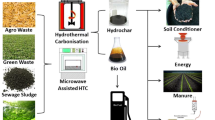Abstract
Ordered mesoporous carbon based catalyst (MCC catalyst) derived from microalgal waste biomass was prepared through condensation and hydrothermal post-treatment process at 90 °C and 120 °C, respectively. Biochar obtained from pyrolysis of the waste was sulfonated in concentrated H2SO4 solution at 150 °C for 15 h to introduce sulfonic groups to the biochar’s structure consisting of condensed polycyclic aromatic rings. This process modified biochar to sulfonated biochar (SBP) which was then applied as precursor in the MCC catalyst preparation. The MCC catalyst structure was demonstrated for its ordered mesoporous structure. The thermal behavior of the catalyst was then investigated by heating process with and without using oxygen for estimating its thermal stability. The acidity of the catalyst was also considered through propylamine-TPD established in TG–MS machine. The catalysts activity was tested in conversion of linseed oil to methyl ester under mild conditions of 120 °C for 3.5 h, and the yield of methyl esters was up to 94.6% proving its high activity and selectivity in the conversion. In this study, TG–DSC coupled with MS, XRD, TEM, NH3-TPD, BET-BJH, techniques were applied to characterize the catalyst, and GC–MS was used for determining the methyl ester composition of the product.
Graphic Abstract
















Similar content being viewed by others
References
Xiaobo Fu N et al (2013) A microalgae residue based carbon solid acid catalyst for biodiesel production. Bioresour Technol 146:767–770
Ramos-Suárez N, Carreras K (2014) Use of microalgae residues for biogas production. Chem Eng J 242:86–95
Lam NK (2012) Microalgae biofuels: a critical review of issues, problems and the way forward. Biotechnol Adv 30(3):673–690
Rashid N, Rehman MSU, Han J-I (2013) Recycling and reuse of spent algal biomass for sustainable algal biofuels. Biochem Eng J 75:101–107
Toda M, Takagaki A, Okamura M, Kondo JN, Hayashi S, Domen K, Hara M (2005) Green chemistry: biodiesel made with sugar catalyst. Nature 438(7065):178
Budarin V, Clark JH, Hardy JJE, Luque R, Milkowski K, Tavener SJ, Wilson AJ (2006) Starbons: new starch-derived mesoporous carbonaceous materials with tunable properties. Angew Chem Int Ed 45(23):3782–3786
Budarin VL, Clark JH, Luque R, Macquarrie DJ, Koutinas A, Webb C (2007) Tunable mesoporous materials optimised for aqueous phase esterifications. Green Chem 9(9):992–995
Kitano M, Arai K, Kodama A, Kousaka T, Nakajima K, Hayashi S, Hara M (2009) Preparation of a sulfonated porous carbon catalyst with high specific surface area. Catal Lett 131:242–249
Shu Q, Zhang Q, Xu G, Nawaz Z, Wang D, Wang J (2009) Synthesis of biodiesel from cottonseed oil and methanol using a carbon based solid acid catalyst. Fuel Process Technol 90(7–8):1002–1008
Gao NZ, Tang S, Cui X, Tian S, Zhang M (2015) Efficient mesoporous carbon-based solid catalyst for the esterification of oleic acid. Fuel 140:669–676
Zhang N, Sun A, Meng Y, Wang L, Jiang H, Li G (2015) High activity ordered mesoporous carbon-based solid acid catalyst for the esterification of free fatty acids. Microporous Mesoporous Mater 204:210–217
Van NKL, Luong TTT (2014) Activated cacbon derived from rice husk by NaOH activation and its application in supercapacitor. Progr Nat Sci 24:191–198
Nguyen HKD, Nguyen DT (2017) Preparation of meso-structured silica–calcium mixed oxide (MSCMO) catalyst for converting Vietnamese rubber seed oil to biodiesel. J Porous Mater 24(2):443–454
Nguyen HKD, Pham PV, Vo AD (2017) Preparation, characterization and thermal stability improvement of mesoporous sulfated zirconia for converting deodorizer distillate to methyl esters. J Porous Mater 24(2):411–419
Nguyen HKD, Pham VV, Do HT (2016) Preparation of Ni/biochar catalyst for hydrotreating of bio-oil from microalgae biomass. Catal Lett 146(11):2381–2391
Nguyen HKD, Vo HV, Anh T, Dang T, Dinh NT (2018) Design of novel order mesostructured superacid catalyst from rice husk for the conversion of linseed oil to methyl esters. Chem Pap 72(1):119–128
Author information
Authors and Affiliations
Corresponding author
Additional information
Publisher's Note
Springer Nature remains neutral with regard to jurisdictional claims in published maps and institutional affiliations.
Rights and permissions
About this article
Cite this article
Nguyen, H.K.D., Tran, H.Q. Thermal Stability of Ordered Mesoporous Carbon Based Catalyst and Its Application in Conversion of Linseed Oil to Methyl Esters. Catal Lett 150, 1028–1040 (2020). https://doi.org/10.1007/s10562-019-03001-4
Received:
Accepted:
Published:
Issue Date:
DOI: https://doi.org/10.1007/s10562-019-03001-4




